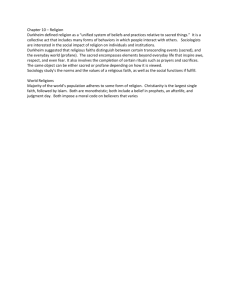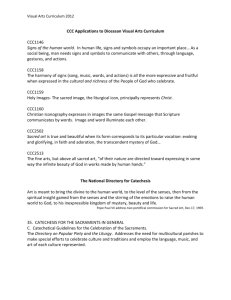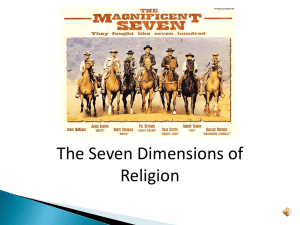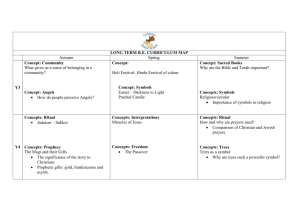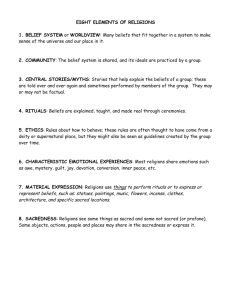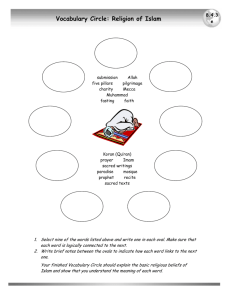The Characteristics of a Religion
advertisement
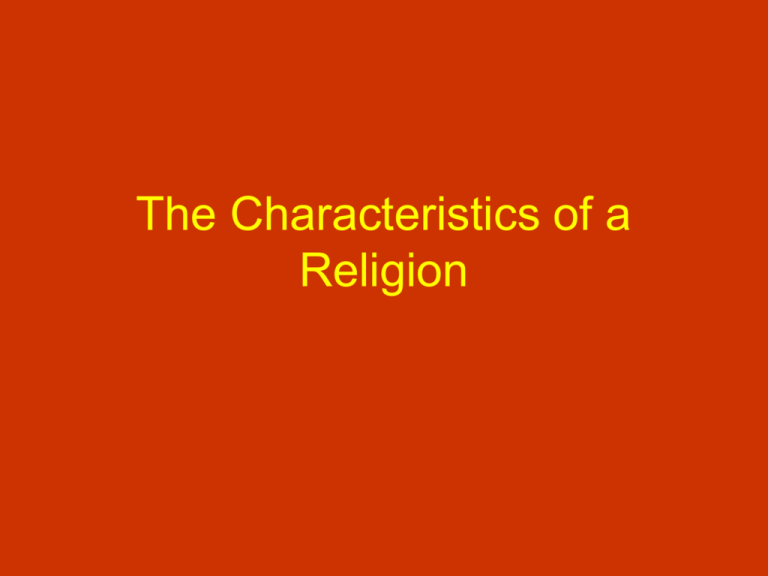
The Characteristics of a Religion There are four major characteristics of any Religious Tradition. RITUAL AND CEREMONY STORIES AND SACRED TEXTS TIME / SPACE / PEOPLE EXPERIENCE RITUAL AND CEREMONY • Structure Mass? Communion Service / Liturgy of the Word? Ritual outside of the Mass? “Other” Rite? • Symbol What symbols are involved in each of the ceremonies? What is the purpose of symbol? What function does it fulfill? RITUAL AND CEREMONY Type of Ritual Rites of Passage (baptism, marriage etc) Rites of Communion Rites of Demarcation (setting apart) Rites of Memorial (Easter rituals) Rites of cleansing (Penitential) RITUAL AND CEREMONY Ceremony is situated within the context of a Ritual as laid down by some rule book? Formal / Informal? Rituals used by the College? STORIES AND SACRED TEXTS All religions have at their centre oral and / or written texts and writings and stories that are both peculiar to and particular to their Religious tradition. Islam: Qur’an (Holy Book) + Sunnah / Sharia Christianity: Bible; Code of Canon Law etc Judaism: Torah (Hebrew Testament) + Halahkah (book of Jewish law) Across religious traditions, there are patterns of similarity in the way people put their lives together in story. For example, Origin and Creation ‘myths’ abound in religions. Similarly, the ‘founder’ or ‘hero’ of a religion is often accorded a ‘miraculous’ birth; a remarkable youth; wisdom or heroism, quite beyond the normal etc. The real beliefs of religious followers often lie behind these stories. Beliefs fall into three areas: • Beliefs about Gods & Spirits; • Beliefs about the world; • Beliefs about life and/or afterlife. TIME, SPACE and PEOPLE Concepts of time and space are as integral to religions as they are to general life. The example is Anzac Day: Sacred Time of the Past: 25 April 1915 (Gallipoli) Sacred Time of the Present: 25 April each year. Sacred Space of the Past: Anzac Cove – Gallipoli Sacred Space of the present: Cenotaph A Church example of this might well be Christmas: Sacred Time of the Past: 25 December ?Year 0 ?? (4 BCE) Sacred Time of the Present: 25 /12 each year Sacred Space of the Past: Bethlehem Sacred Space of the present: Church (Nativity Scene) Sacred persons are also integral to religions, Again, there is a past and present dimension to this. Sacred persons of the past are those legendary heroes, founders and saints who are instrumental to the religion’s history and traditions. People such as Buddha; Jesus; Muhammad and Moses are examples of this. Sacred persons of the present are those held in high regard and authority in their religious tradition: Chief Rabbis (Judaism); Imams (Islam); Priests; Bishops, Pope (Christianity, especially within the Catholic denomination etc). EXPERIENCE All of the elements work together to make involvement in the religion a meaningful experience. That is, when a person engages in a ritual, knowing the underlying story, adhering to the underpinning beliefs, being conscious of the sacred time, space and persons involved, this person is likely to be open to what is generally called a religious experience. The degree to which one involves him/herself in a religious ritual determines the intensity of the religious experience. EXPERIENCE - Christian • Low Level Experience – participant at Mass (for example) • High Level Experience – baptism where you are the father; God Father / Marriage, where you are part of the Bridal party etc. - Judaism •Low level Experience - Observer in a Brit Milah ceremony •High Level Experience – Sandek, mohel, etc. There are four major characteristics of any Religious Tradition. RITUAL AND CEREMONY STORIES AND SACRED TEXTS TIME / SPACE / PEOPLE EXPERIENCE



